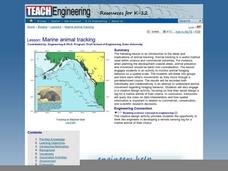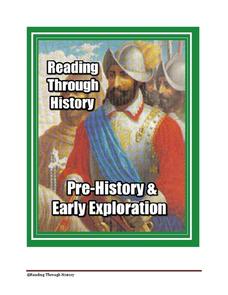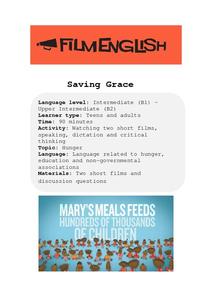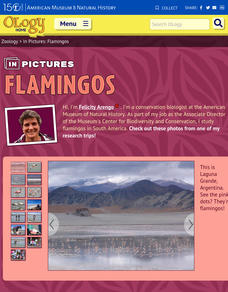Foraging Teacher Resources
Find Foraging lesson plans and worksheets
Showing 44 resources
Curated OER
Echinoderms
Echinoderm structure and characteristics are the focus of this reading comprehension and labeling worksheet. Attractive diagrams and ample information make this a suitable homework assignment for your biology buffs when learning...
Prince William Network
The Incredible Journey
Divide your school gym into breeding grounds and non-breeding grounds so that your zoologists can play a game simulating the seasonal migration of shorebirds. Players pick one of the included game cards and follow its directions, which...
Curated OER
Marine Animal Tracking
Students engage in a lesson which serves as an introduction to the ideas and implications of animal tracking. They monitor animal foraging behavior on a spatial scale. The students break into groups and track each other's movements as...
Curated OER
Using Math To Make Decisions About Animal Habitat
In this animal habitat worksheet, students read, analyze and solve 5 scenarios involving mathematics and animal habitats. Students work out each decision they decide as correct and write out a proposal for each one.
Curated OER
Map-A-Buddy
Students investigate the concept of tracking and spatial movements of animals in relation to the environment in which they live. They participate in an interactive activity by tracking one another over a pre-defined region, record the...
TED-Ed
The True Story of Sacajawea
The story of Sacajawea's incredible role as the guide in the Lewis and Clark expedition across America is captured in this engaging, animated video. Learn about the efforts she took to support the explorers, including translating,...
Curated OER
Build a Hawaiian Bird
Fifth graders make a model of a bird. In this animal adaptations lesson, 5th graders examine how birds adapt to their environment, using Hawaiian birds as an example. Students create their own bird using adaptation paper cut outs...
TED-Ed
The Lovable (and Lethal) Sea Lion
What lives in the ocean, has ears, walks on all fours, and can reach a top speed of 18 miles an hour? Why, the sea lion, of course! A cute, animated video introduces viewers to the majestic aquatic mammal.
Curated OER
Optimal Foraging
Students participate in a foraging activity that demonstrates environmental conditions playing an important role in determining the optimal foraging behavior of a particular organism.
Khan Academy
The Agricultural Revolution
Rather than simply define the agricultural revolution, invite your learners to consider the advantages and disadvantages that agriculture has brought to humanity as a whole. John Green begins this first episode of this series by...
FuseSchool
Selective Breeding
Did you know that selective breeding is behind the food we're eating? Discover the agricultural practice that changed humans from foragers to farmers using an insightful video that is part of the Fuse School playlist on Evolution. Young...
TED-Ed
Mating Frenzies, Sperm Hoards, and Brood Raids: the Life of a Fire Ant Queen
The dramatic story of the life cycle of a fire ant queen is featured in a short video that details the queen's struggle to survive amid floods, fierce battles, and forage wars.
Curated OER
Animal Feeding Strategies
In this food web study worksheet, students record how 24 animals get their food. Each animal should categorized as a forager, grazer, filter feeder, parasite, predator, or scavenger on the graphic organizer.
Curated OER
Graze Like a Cow
Students explore how a cow digests the grass they eat. In this science/math instructional activity, students compare the quality of forage. Additionally, students determine the effects of rangeland health on the production.
Curated OER
Insects!
Students explore the diet of insects. For this "insects" biology lesson, students take a nature walk and collect various natural materials they think may be eaten by insects. Students sort and classify these materials into three diet...
Curated OER
Paws, Claws, Hands, and Feet
In this animal hands and feet worksheet, students complete 4 pages of exercises that pertain to claws, paws, hands and feet. Students read clues and match them to the animals. Students analyze pictures of animal parts and match them to...
Curated OER
Penguins Nesting Know-How
Students maintain a field journal as they follow penguin parents raising their chicks during the breeding season. They formulate testable questions. Students reflect on animal behavior in the field related to survival and chick rearing.
Curated OER
Measuring Feeding Trays
Pupils measure the remains of a feeding tray after its left overnight near the Jordanelle Reservoir. They test animal foraging behaviors. Students document their findings and then share their findings with the classroom.
Curated OER
Adaptations To the Environment
Young scholars design and construct an imaginary animal that is perfectly adapted to a particular type of biome. They give the animal a scientific name, place it in a phylum and write descriptions about its behavior, reproduction,...
Curated OER
Are There Too Many Elk?
Students study elk populations in Arizona. In this data lesson plan students read an article on monitoring elk populations, analyze data and make management recommendations.
Curated OER
Are There Too Many Elk?
Students use information about elk populations in Arizona to make recommendations about population management. In this ecology lesson plan, students discover the problems associated with having a heard of elk that is too large. After...
Reading Through History
Early History and Exploration Unit
We all know about Christopher Columbus, but who else explored the Americas, and specifically, the future United States of America? Learners find out these answers and more in a resource that includes four different reading sections,...
Film English
Saving Grace
Bring up the topic of world hunger in your class with two emotional videos. The short films are about a program for educating and feeding children around the world. Class members talk about poverty and pay close attention to the...
American Museum of Natural History
In Pictures: Flamingo
Fifteen photos take scholars on a journey to Laguna Grande, Argentina to observe how a group of scientists work with native flamingos. Stunning images showoff the flamingo, its environment, scientists in the wild, and the impact the...

























